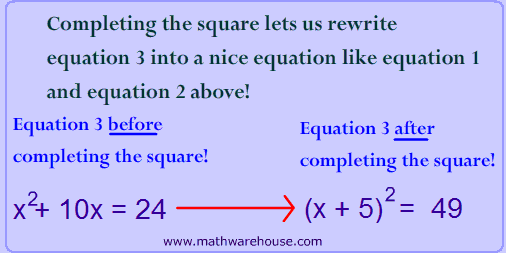What does "completing the square" do for us?
It gives us a way to find the last term of a perfect square trinomial.
Okay, what is a "perfect square trinomial"??
A perfect square trinomial is a polynomial that you get by squaring a binomial. (binomials are things like 'x + 3' or 'x − 5').
Examples of perfect square trinomials- $$ x^2 + 2x + 1$$ This is a perfect square trinomial because it equals $$(x + 1)^2$$.
- $$x^2 + 4x + 4$$ This is a perfect square trinomial because it equals $$(x + 2)^2$$.
- $$x ^2 + 6x + 9 $$ This is a perfect square trinomial because it equals $$(x + 3)^2$$.
These are NOT perfect square trinomials.
- $$x ^2 + 3x + 2 $$ This is not a perfect square trinomial because it equals $$ (x + 1)(x + 2) $$.
- $$x ^2 + 7x + 10 $$ This is not a perfect square trinomial because it equals $$ (x + 2)(x + 5) $$.
- $$ x ^2 - 9$$ This is not a perfect square trinomial because it equals $$ (x \red{+} 3) (x \red{-} 3) $$.














